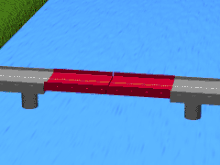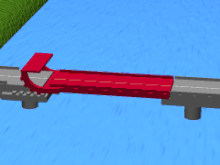Bascule bridge
A bascule bridge , also known as a bascule bridge , is a movable bridge that crosses other traffic routes - often shipping routes - that only occasionally require greater clearance. The movable part of the supporting structure (the flap) is rotatably mounted about a horizontal axis and balanced with the rear rods located under the fixed bridge part. The bascule bridge is easier to move than the drawbridge , since only the frictional resistance of the engine (e.g. hand winch and pull chain or rope) has to be overcome.
Types
Dutch bridges
Dutch bridges are known with their high counterweight, as z. B. van Gogh immortalized in some pictures, so z. B. the bridge at Langlois near Arles (built 1820–1830). Another wooden bascule bridge of this type from the 19th century is the Wiecker Bridge near Greifswald (built in 1887) , which is still in operation .
The longest bascule bridge in Germany is the Jann Berghaus Bridge near Leer with a total length of 464 m. The Rethe bascule bridge in Hamburg has a longer free span of a total of 104.2 m. The largest bascule bridge is the Porta d'Europa with a span of 106 m in the port of Barcelona .
Folding bridges
In Chicago there is a bascule bridge with a clearance of 20 m. In order not to make their flaps too clumsy, they fold up when they are raised. That is why such a type of bridge is called a folding bridge. In Kiel , a three-span bascule bridge leads over the Hörn .
Swing, luffing or roller bascules

Another type of bridge shows flaps that are arched after the support. When erecting, the flaps do not rotate around an axis like the typical bascule bridges, but roll the circle segment on a horizontal path, being guided by toothed racks . This results in a better distribution of forces and a faster way of working. This type of bridge is known as a swing or luffing bridge.
By means of a counterweight lying high above the access to the bridgehead, the center of gravity can be placed in the (or appropriately: near the) axis of rotation so that the force for opening and closing the folding arm is only its rolling friction on the racks (plus or minus a small torque that always puts the engagement pressure on only one side of the tooth flanks) must overcome.
The American engineer William Donald Scherzer developed a special design, the roller bascule bridge, in which the drive attaches to the pivot point of the system and moves it horizontally. Well-known examples of this type of construction are the Pegasus Bridge and the Pamban (railway) bridge .
photos
Conversion of a disused bascule bridge
A disused bascule bridge Pont basculant de la Seyne-sur-Mer in La Seyne-sur-Mer was permanently folded up and converted into a lookout tower.
See also
- In the case of lifting bridges , the track or the track support can be lifted.
- A list of bascule bridges can be found in the bascule bridge category .
- List of movable bridges in Germany
- Tipping bridge (bridge)
literature
- David J. Brown: Bridges - Bold constructions over rivers, valleys, seas. Callwey-Verlag, Munich 1994, ISBN 3-7667-1114-8 .
- Richard R. Dietrich: The fascination of bridges. Architecture - history - technology. Callwey, Munich 1998, ISBN 3-7667-1326-4 .
- Fritz Leonhardt: Bridges. Deutsche Verlags-Anstalt, 2002, ISBN 3-421-02590-8 .









